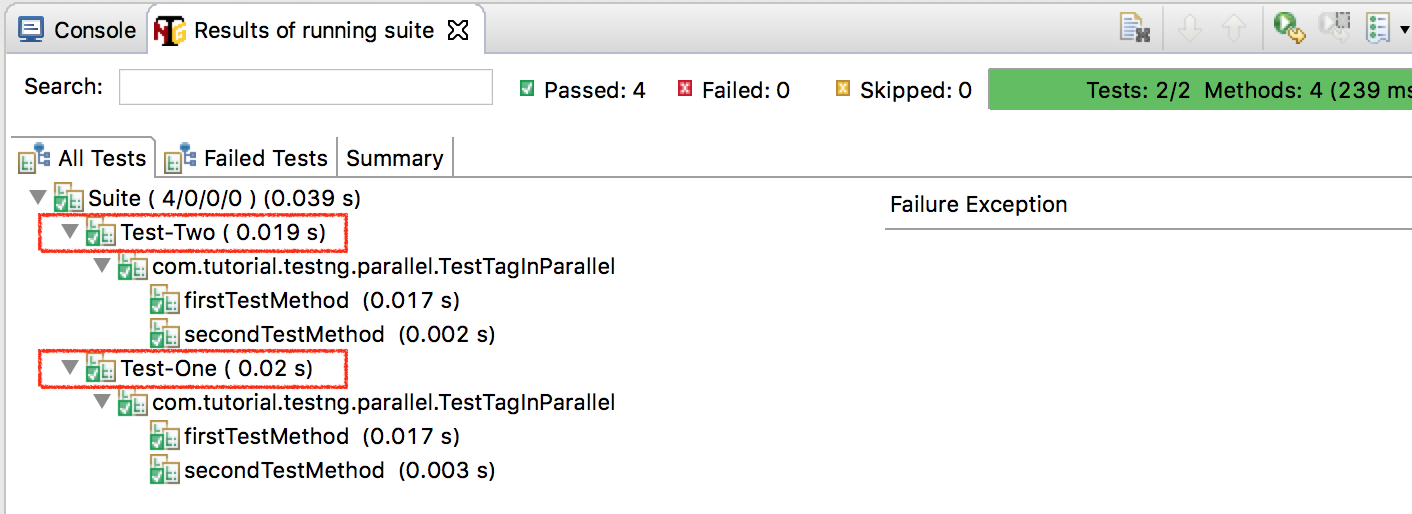TestNG allows the tests to run in parallel or multi-threaded mode. Parallel test are helpfull for reduction in test execution time.TestNG use the concept of multi-threading from Java. In the configuration file, the parallel attribute on the tag us been used for the parallel execution using the testng.xml file. Example:
<suite name="Suite" parallel="methods" thread-count="2" configfailurepolicy="continue">
Parallel attribute take multiple values, Below are the valid values:
- parallel= methods : Run all your test methods in separate threads.
- parallel= tests : Run all the methods in the same
tag in the same thread, but each tag will be in a separate thread. - parallel= classes : Run each class in a separate thread but all the methods in the same class in the same thread.
- parallel= instances : Run all the methods in the same instance in the same thread.
thread-count attribute value allows you to specify how many threads should be allocated for the execution.
configfailurepolicy attribute value as continue allows Test to continue running after Failures.
Lets create an Example for all the values for parallel attribute type.
1. Test methods in parallel:
To Run Test methods parallel each test method will run in a separate single thread, So we will print the Thread ID for the particular Test and which should be different.
package com.tutorial.testng.parallel;
import org.testng.annotations.Test;
public class MethodInParallel {
@Test()
public void firstTestMethod() {
System.out.println("First test method, ThreadID:" + Thread.currentThread().getId());
}
@Test()
public void secondTestMethod() {
System.out.println("Second test method, ThreadID:" + Thread.currentThread().getId());
}
}
xml version="1.0" encoding="UTF-8"?>
http://testng.org/testng-1.0.dtdOutput:
After running the testng.xml file we can see the output with both the test methods in different ThreadID as 11 and 10, which means both test ran in parallel Thread.
Second test method, ThreadID:11
First test method, ThreadID:10
===============================================
Suite
Total tests run: 2, Failures: 0, Skips: 0
===============================================
2. Test Class in parallel:
To Run Test Class parallel meaning each Class will be executed in a different Thread and the same thread is used for Test method Execution. For this Example We need to Create 2 Class which will Run in Parallel.
package com.tutorial.testng.parallel;
import org.testng.annotations.Test;
public class ClassInParallelOne {
@Test()
public void firstTestMethod() {
System.out.println("First test method from Class One, ThreadID:" + Thread.currentThread().getId());
}
@Test()
public void secondTestMethod() {
System.out.println("Second test method from Class One, ThreadID:" + Thread.currentThread().getId());
}
}
package com.tutorial.testng.parallel;
import org.testng.annotations.Test;
public class ClassInParallelTwo {
@Test()
public void firstTestMethod() {
System.out.println("First test method from Class Two, ThreadID:" + Thread.currentThread().getId());
}
@Test()
public void secondTestMethod() {
System.out.println("Second test method from Class Two, ThreadID:" + Thread.currentThread().getId());
}
}
xml version="1.0" encoding="UTF-8"?>
http://testng.org/testng-1.0.dtdOutput:
After running the testng.xml file we can see the output as Class One is using ThreadID:10 and Class Two is using ThreadID:11. Both the Test methods from Class Ran in the Same Thread.
First test method from Class One, ThreadID:10
Second test method from Class One, ThreadID:10
First test method from Class Two, ThreadID:11
Second test method from Class Two, ThreadID:11
===============================================
Suite
Total tests run: 4, Failures: 0, Skips: 0
===============================================
3. Tests Tag Inside Suite in parallel:
Run all the methods in the same tag in the same thread, but each tag will be in a separate thread. In this Example we will see executing each test inside a suite in parallel, each test that is part of the test suite execution will be executed in its own separate respective thread.
package com.tutorial.testng.parallel;
import org.testng.annotations.Test;
public class TestTagInParallel {
@Test()
public void firstTestMethod() {
System.out.println("First test method, ThreadID:" + Thread.currentThread().getId());
}
@Test()
public void secondTestMethod() {
System.out.println("Second test method, ThreadID:" + Thread.currentThread().getId());
}
}
xml version="1.0" encoding="UTF-8"?>
http://testng.org/testng-1.0.dtdOutput:
After running the testng.xml file we can see the output as Test Test-One is using ThreadID:10 and Test Test-Two is using ThreadID:11. All the Class Inside the Test Tag will Run under same Thread.
First test method, ThreadID:11
Second test method, ThreadID:11
First test method, ThreadID:10
Second test method, ThreadID:10
===============================================
Suite
Total tests run: 4, Failures: 0, Skips: 0
===============================================

No comments:
Post a Comment